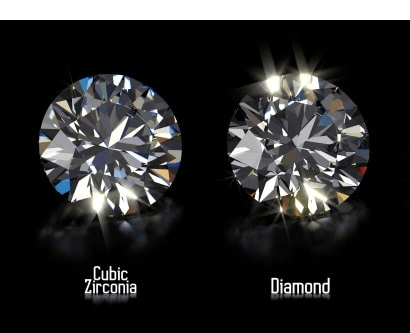
Diamond vs. Cubic zirconia: how to distinguish?
Contents:
Diamond is an extremely rare gemstone found naturally in nature. Cubic zirconia, on the other hand, is synthetic product, produced in laboratories - we can say that this is just an artificial, synthetic diamond. These two stones, although similar in appearance, are completely different in structure, properties and price. That's why it's so important to be able to tell them apart. Fortunately, apart from a visit to the jeweler, there are several home ways to find out if we are dealing with a diamond or cubic zirconia.
Distinguishing a Diamond from Cubic Zirconia - Light Test
A polished diamond, that is, a diamond, under the influence of light shimmers mainly in muted shades of gray and white. It has the so-called brilliant. There may also be a red or orange glow. By directing the light on the zircon, we will see the cannonade all the colors of the rainbow. So, if, for example, after exposure to sunlight, we notice a stone around green or yellow — we are dealing with cubic zirconia.
Diamond vs. Cubic Zirconium - Thermal Test
An interesting feature of diamonds is that they do not heat up when exposed to hot liquids or the sun. Using this feature, we can verify the authenticity of the stone. It is enough to put it in warm water and, taking it out, check if its temperature has changed. The temperature of the cubic zirconia will increase, while the temperature of the diamond will remain the same.
Checking the purity of diamonds and cubic zirkonia
If the stone is not already embedded in the ring, we can make a so-called transparency test. It is enough to put a stone on the page of a book and see if you can see the letters under it. In this case cubic zirconia works like a lens and it will allow you to see and even read the words. In turn, the rhombus, due to its structure, will block the view or even make it impossible to recognize letters.
What else distinguishes a diamond from cubic zirconia?
In addition to opacity, reaction to heat and shine diamonds are also particularly hard. These are the hardest natural minerals. We can only scratch them using another diamond. Meanwhile, scratching cubic zirconia is much easier. However, this is a risky way to distinguish cubic zirconia from diamond, so it is better to stick to other, safer methods. The key issue is the purity of the ore. It is because of her that mistakes often occur between a diamond and cubic zirconia. Contrary to appearances, it is the latter that is characterized by a higher degree of purity. This is because diamonds naturally occur in the environment and in turn invariably come in varying degrees of clarity. Cubic zirconia produced in the laboratory is free of impurities and defects.Due to the hardness of a diamond, its facets are difficult to polish, so its edges always remain sharp. If cubic zirconia is used for a long time, its edges may blur and lose their sharpness. The durability of diamonds is also an important characteristic. Engagement ring with a diamond even after many years won't lose its luster and will continue to please with its beauty, and the zircon ring will eventually undergo a tarnishing process, as a result of which it may lose its ability to reflect color reflections.
Leave a Reply